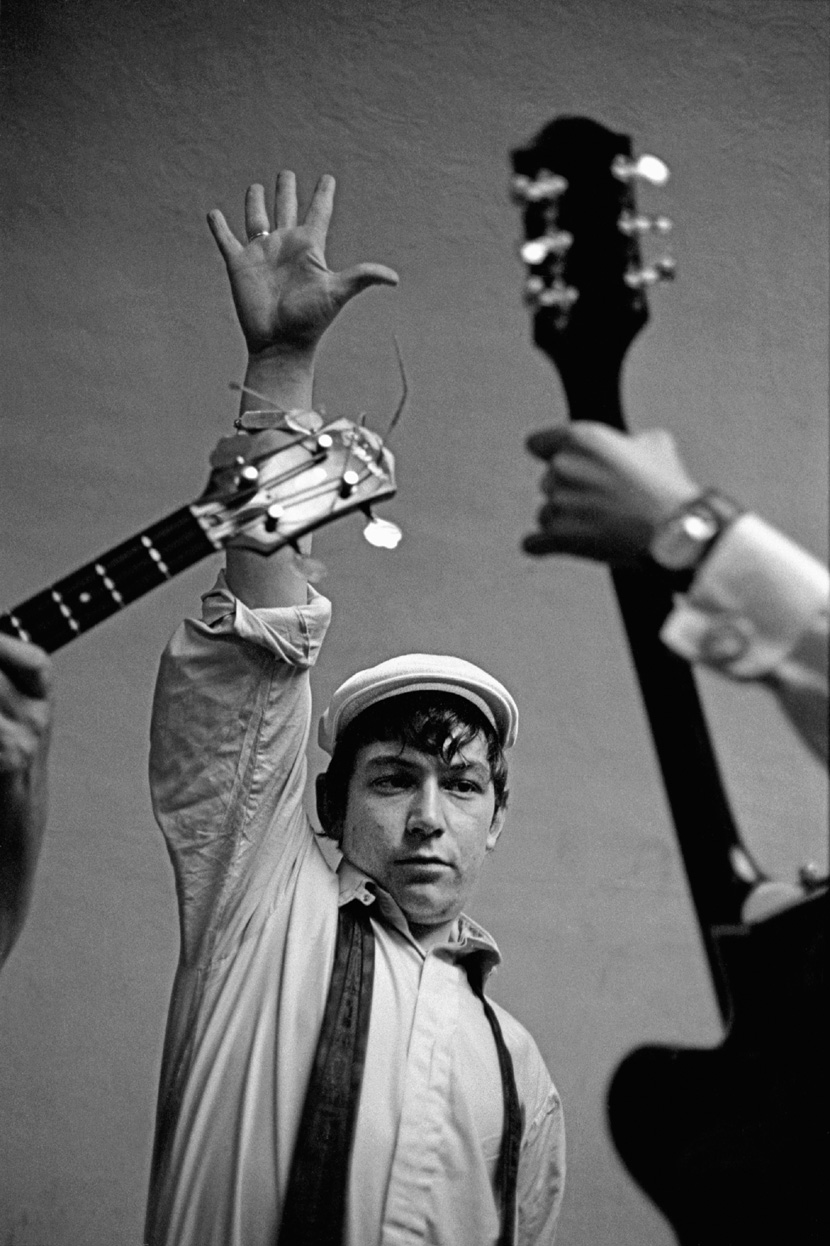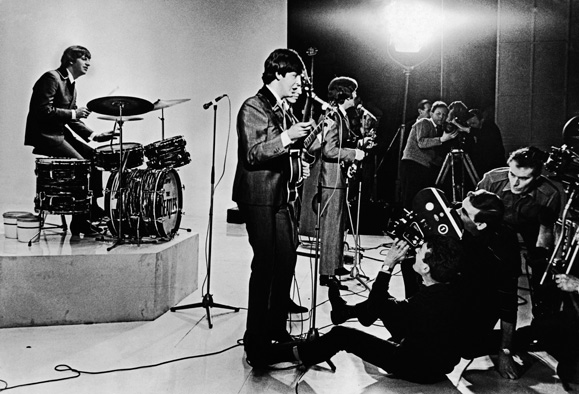
In the search for publicity, the Dave Clark Five aped the fresh and emerging face of pop inspired by the Beatles throughout 1963.
Photograph by Terry O’Neill

The Dave Clark Five, summer 1963. The band was named after its front man, but it was keyboard player and vocalist Mike Smith (rear left) who gave the band credibility.
Photograph by Terry O’Neill

Terry O’Neill’s shot of a barefoot Jean Shrimpton on a rain-soaked street on her way to a fashion shoot typified the unconventional and informal attitudes of young women in 1963.
Photograph by Terry O’Neill

Vogue photographer David Bailey and his muse Jean Shrimpton were the couple that exemplified London’s emergence as the fashion capital of the world in 1963.
Photograph by Terry O’Neill

Convent-educated Jean Shrimpton was the highest-paid supermodel of the 1960s and Cockney rebel Bailey the most in-demand photographer in the world.
Photograph by Terry O’Neill

David Bailey was the enfant terrible of fashion photography whose working class charm and chutzpah delighted American Vogue editor Diana Vreeland.
Photograph by Terry O’Neill

The Beatles take a break in the backyard of the Abbey Road studios in London in January, 1963, while recording their first hit single, “Please Please Me.”
Photograph by Terry O’Neill

The Beatles share a joke with legendary producer Sir George Martin (second left) during the “Please Please Me” recording session.
Photograph by Terry O’Neill

George Harrison tunes his guitar.
Photograph by Terry O’Neill

Ringo Starr gave the Beatles and Sir George Martin new vigor with his drumming.
Photograph by Terry O’Neill

The Beatles, with Sir George Martin (background), do the paperwork. The “Please Please Me” album took three three-hour sessions and cost £400 to record.
Photograph by Terry O’Neill

Listening to the playback.
Photograph by Terry O’Neill

“I was just seventeen playing gigs. There was a club mentality, a very strong underground like the Stones or Brian Augur. We were all club musicians. I liked it. I identified with it.”
Eric Clapton
Credit: Getty Images

“The Stones told us ‘when you get paid,’ you went straight to Mr. Fish and bought clothes. We had fire in us and we had money. I was earning more than my father.”
Eric Stewart
Credit: Getty Images

“The Flamingo Club was different, frequented by black American GIs from the airbases. It was their home in London. They’d come down loaded with Bourbon and play an album, Mose Allison, then come back a month later with a new album.”
Georgie Fame
Credit: Getty Images

“We were the first generation of girls who could leave home before getting married. We were a power to be reckoned with because it was easy to get a job. There were two million of us with buying power. Teenagers were having a ball everywhere.”
Mandy Rice Davies
Credit: Getty Images

“We all wanted to be thin, to look great in the new clothes. The doctors gave us slimming pills, speed, if we wanted them, and there were biscuits you could buy that made you feel full. I would eat them so I didn’t have to eat all day.”
Pattie Boyd
Credit: Getty Images

“I was walking down Bond Street and there was a sign, VIDAL SASSOON, and a picture of a haircut that knocked me sideways. I knew I wanted my hair cut like that.”
Mary Quant
Credit: Getty Images

“The Rolling Stones were just these boys walking down the street. First time we got some cash we all went out and bought new guitars and Beatles boots.” Keith Richards
Photograph by Terry O’Neill

The photographer Terry O’Neill chose a harder, edgier style to shoot the Rolling Stones in London’s Tin Pan Alley to differentiate them from the clean-cut Beatles and other bands.
Photograph by Terry O’Neill

In 1963 television appearances, the Rolling Stones were expected to conform to a smart dress code with jackets and ties, but they soon shed that respectable image—it didn’t match the music or the act.
Photograph by Terry O’Neill

“We hated our first record. We refused to play it live. It didn’t sound good to us so we just didn’t do it. We were not that kind of calculating money machine.”
Keith Richards
Photograph by Terry O’Neill

Photograph by Terry O’Neill

“Jagger was known to everyone simply as ‘the rhythm and blues singer.’ I thought it was a joke until I saw him perform. It was alchemy.”
Norman Jopling
Photograph by Terry O’Neill

“Photographer Terry O’Neill remembers the Rolling Stones were ‘immediately cool.’ I was just trying to be polite and not get busted.”
Keith Richards
Photograph by Terry O’Neill

Photograph by Terry O’Neill

“When I sent the Stones photographs to my picture editor, he went berserk. ‘They’re ugly—get me a pretty band like the Beatles.’”
Terry O’Neill
Photograph by Terry O’Neill

Keith Richards called the Stones’ young manager, Andrew Loog Oldham (pictured here with Charlie Watts), the sixth Stone. “I do love that man. He forged this thing.”
Photograph by Terry O’Neill

“Brian Jones felt threatened because he had control of the Rolling Stones until I came along. In any band there’s a group leader until there’s a manager.”
Andrew Loog Oldham
Photograph by Terry O’Neill

Stones manager Andrew Loog Oldham and Mick Jagger. “The big difference between the Beatles and the Stones were [that] the Beatles made it in America. The Stones were made by America.”
Andrew Loog Oldham
Photograph by Terry O’Neill

Jagger, Richards, and Loog Oldham (background) in the studio with Lionel Bart, songwriter, pop impresario, and composer of the hit musical Oliver!.
Photograph by Terry O’Neill

Spotted by a British producer in a Greenwich Village folk club, the unknown Bob Dylan was flown to Britain to perform in a televised drama and honed his act in London folk clubs after rehearsals.
Credit: Getty Images

An outtake from the the now-iconic album cover of Freewheelin’ Bob Dylan with Susie Rotolo, taken on the corner of Jones and West Fourth Street in Greenwich Village. The album reached number 22 in the United States but hit the top spot in Britain.
Credit: Getty Images

“When I first heard the Beatles it had an impact. You were aware of new music and new people. I was breaking boundaries in journalism. I always felt it could be an art form. Literature and the laws changed.”
Gay Talese
Credit: Getty Images

Carly and Lucy Simon toured Greenwich Village clubs and Ivy League campuses with their folk-rock repertoire but scored only one minor hit before Carly’s solo career took off in 1971.
Credit: Getty Images

“When I saw the Beatles, that was my eureka moment. Less than a year later we were in America. We did 365 concerts in one year. The Beatles thought we were fluff. We weren’t in the same league.”
Peter Noone
Credit: Getty Images

“The suits were in charge of television and radio, they and the assholes of EMI and Decca. I thought about a boat, offshore, where they couldn’t touch us, broadcasting my kind of music.”
Ronan O’Rahilly
Credit: Getty Images

“The mood was new music. It was more rebellious, more evasive writing, more metaphorical. I’d had ten hits in a row and then the Beatles and the Stones came in and … I was the outsider. My records stopped selling.”
Neil Sedaka
Credit: Getty Images

Photograph by Terry O’Neill

“I heard about this band the Animals coming into London from Newcastle. I took them shopping first, then to a studio, because they didn’t look the business. They looked like laborers.”
Terry O’Neill
Photograph by Terry O’Neill

Photograph by Terry O’Neill

Photograph by Terry O’Neill

Eric Burden (left) and lead guitarist Hilton Valentine. “I don’t know when we changed our name to the Animals but I think it was our first trip down to London.”
Hilton Valentine
Photograph by Terry O’Neill

“The Animals were very tough cookies. Very suspicious. Alan Price (below) was very smart, and Chas Chandler was physically hard.”
Georgie Fame
Photograph by Terry O’Neill

“The studio was a rehearsal place where violinists went. We didn’t last long there. They told us to leave because we were so loud. It was unusual in the beginning being photographed. And it was the beginning.”
Hilton Valentine
Photograph by Terry O’Neill

Photograph by Terry O’Neill

Photograph by Terry O’Neill

The Beatles film a scene for A Hard Day’s Night at a theater in London.
Photograph by Terry O’Neill

Photograph by Terry O’Neill

Photograph by Terry O’Neill

Photograph by Terry O’Neill

Within a year of the release of “Please Please Me,” the Beatles had performed before 75 million Americans on The Ed Sullivan Show and flown home to film A Hard Day’s Night and record Around the Beatles.
Photograph by Terry O’Neill

During the filming of Around the Beatles, McCartney and Lennon spoofed Pyramus and Thisbe (from Shakespeare’s A Midsummer Night’s Dream), seen here in rehearsals, and Ringo Starr donned a Tudor costume for his part.
Photograph by Terry O’Neill

Photograph by Terry O’Neill

Photograph by Terry O’Neill

Pattie Boyd, her future husband George Harrison, Cilla Black, and Brian Epstein dine out in London during filming of A Hard Day’s Night.
Photograph by Terry O’Neill

“Davy Jones [David Bowie] and I would bring our guitars to school and sit on the stairs and play during the lunch break. I was thirteen. He was sixteen.”
Peter Frampton
Credit: Getty Images